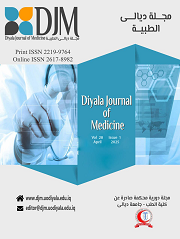Relationship Between Entrance Surface Skin Exposure for Iraqi Women with Compressed Breast Thickness in Mammography
Main Article Content
Abstract
Background: The evaluation of compressed breast thickness has been conducted based on the results of mammography examinations. While it is well-established that breast compression influences breast tissue, its effect on the axillary (armpit) region remains unclear. Increased compression of breast tissue in women can lead to a reduction in breast tissue thickness.
Objective: To determine the correlation between entrance surface skin exposure with compressed breast thickness and compare the mean of entrance surface skin exposure results from mammography in Iraq with other studies.
Patients and Methods: A study was conducted at Al-Alwiya Teaching hospital from December 2023 to January 2024 and involved 100 Iraqi women. The study used a mammography (model GE healthcare) to determine compressed breast thickness and skin exposure for craniocaudal and mediolateral oblique projections.
Results: The mammography findings revealed a statistically significant correlation between entrance surface skin exposure (ESE) and compression breast thickness (CBT) in Iraqi women. Specifically, it was observed that increased CBT was associated with higher ESE values.
Conclusion: The study demonstrates that breast compression thickness and radiation exposure were notably higher in the mediolateral oblique (MLO) view compared to the craniocaudal (CC) view. A significant positive correlation was observed between compression breast thickness and radiation dose. These findings underscore the importance of region-specific guidelines and standards in mammography practices to ensure optimal patient care and safety.
Keywords: Axillary region, Breast parenchyma, Entrance surface skin exposure, Mammography, Compressed breast thickness.
Downloads
Article Details

This work is licensed under a Creative Commons Attribution 4.0 International License.





